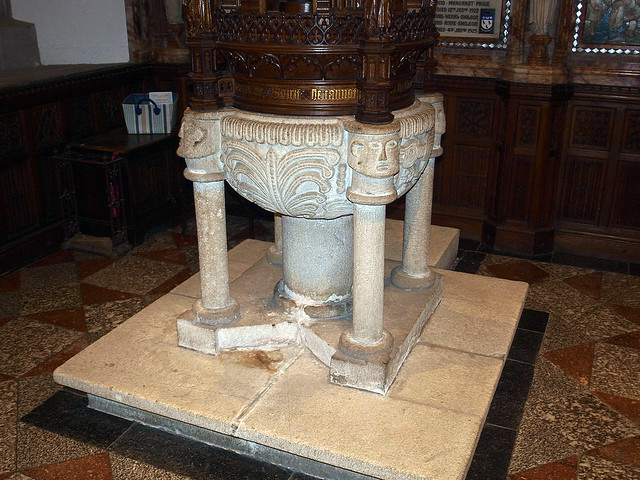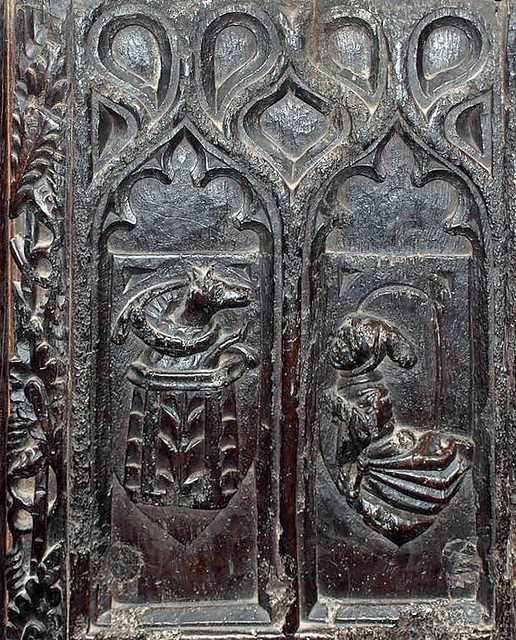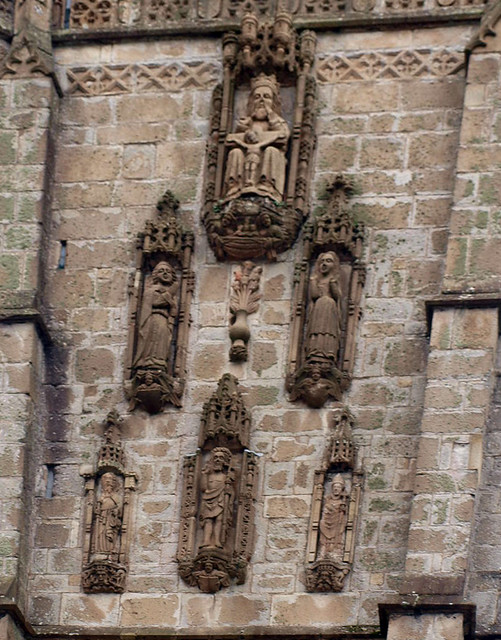The chief attractions here are the tower statuary and carving, a fantastic font with cover and what appear to be redundant bench ends in the tower. Also what I mistook for a benefactions board turned out to be "a letter to the inhabitants of the county of Cornwall" from Charles I dated 1643.
HOLY TRINITY. The most noteworthy feature of the tower is its enrichment on all four faces by figure sculpture in niches. On N, E, and S are four apostles each, on the W is a pyramidal group of the Trinity at the top, Annunciation below, with the lily as an isolated motif between the two kneeling figures, and the risen Christ between two saints at the foot. The style is that familiar from C15 alabaster work, rather hard and stocky. The top of the tower, with the usual pinnacles, has four strips of ornament of the type as found at Launceston or St Mary Truro, or Fowey.* The tower can be dated by the coat of arms of Bishop Courtenay (1478-87). It is faced with Pentewan stone. Interior of nave with five bays, chancel with two bays, N and S aisles, two-storeyed S porch. Mainly C15. Of earlier buildings the following fragments or parts can still be seen: the circular pier of the S chancel arcade, the two responds of the arches, and the double-chamfered arches themselves are early C13 ; the N chancel arcade is also E.E., but later, with a handsome octagonal pier with four slim attached shafts in the diagonals, a motif which comes from Dartmouth and its neighbourhood; the chancel E window and N aisle E window with intersecting tracery and pointed quatrefoils look c.1300, and it is quite probable that they and the N chancel aisle can be connected with the date c.1290, recorded for the endowment of a chantry chapel of St Michael. The nave is disappointing inside, much restored in 1872 (by G. E. Street. The alabaster reredos and pulpit are his). The piers are slender, of standard Cornish section, with moulded capitals and on the s side some decoration of the abaci. The aisles have wide Perp windows giving an even light. The old wagon roofs are original; they rest almost immediately on the arcades. Outside, the church is much more attractive, with battlemented aisles and a battlemented, buttressed, two-storeyed S porch with a curious doorway with openwork tracery: an ogee arch inscribed into a round one (cf. Mylor, St Just-in-Roseland; the motif really originated at Gloucester and is to be found, for example, in tomb canopies at Tewkesbury). There are also carved shield-holding angels, and shields with carved Instruments of the Passion, Resurrection, Ascension, and Christ in Glory. - FONT. Norman, of Bodmin type, with faces at the corners, ‘trees of life’, and dragons. - PILLAR PISCINA. Norman, and of interesting design. - BENCH ENDS. Only a few are preserved; and only a small part (on the S) of the ROOD SCREEN. - CLOCK FACE outside the W tower, with twenty-four bosses for the hours; probably C16. - OAK CHEST. 1669. - PLATE. Two similar gilt Cups, with strapwork decoration, London, 1573-4; also pieces of 1707, 1708, 1751, 1753. - MONUMENT to Joeseph Sawle d. 1769, by Isbell. Free standing, about 6 ft high; black urn on a square base.
* Mr A. L. Rowse calls this a Somerset type of tower - a class which extends in a band all the way across the West Country from Cornwall to Oxford. The elaborately carved stonework of the topmost stage is typical. (St Austell, H. E. Warne, 1960.)
ST AUSTELL. We may wonder at the sight of something like a range of snowcapped peaks as we come to it on a summer's day, but here they are, apparently eternally, the work of a Quaker who turned St Austell upside down, changing its green valleys to white hills.
For centuries the neighbourhood has been famous for its tin, now it is famous for white clay. It was here that William Cookworthy found his first examples of the clay which was to give Cornwall a new industry. He found it here before he discovered the huge deposits at Carclaze mine, one of the sights of Cornwall two miles away. Open to the day, the great Carclaze mine has been quarried for tin from time immemorial. It must have been yielding tin when the Phoenicians came this way. It astonishes us by its immensity, a mile round and 150 feet deep, a match for the great slate quarry at Delabole. From it go pipes to Charlestown, .the liquid clay running along them to be dried and shipped for the Potteries.
The moors are honeycombed with mines and quarries. There is a wishing well on the Bodrnin Road, an old stone by the church where tradition says a witch was burned alive, and a stream hereabouts that yielded a rare treasure for the British Museum behind which is a queer story. A thousand years ago, when the Vikings were harrying Cornwall, a Saxon priest hid his treasure in a heap of loose stones under a slate. His chief treasure was a silver chalice of King Alfred’s day and small ornaments and a silver wire with a glass bead at the end. Slowly the earth covered the hoard till it was 17 feet deep, and at last the tin miners of St Austell brought it to light. The silver wire with the bead at the end is known as a scourge, and is said to be the only complete one of its kind.
The fine church in the heart of this busy town stands among palm trees, rising from a lovely lawn. We see its tower from far away standing on a hillside among the trees. Five centuries old and 90 feet high to its battlements, it is one of the finest towers in Cornwall, with rich pinnacles, and grotesques on the walls looking as though they would leap down. On three sides of the tower are the Twelve Apostles and on the west wall are sculptured groups showing souls in Abraham’s bosom, Gabriel bringing the good news to the Madonna, and figures of our Lord, a bishop, and a priest. The clock above all these has a 24-hour dial; centuries before the BBC tried to make us count in twenty-fours this was a 24-hour clock, and is the only clock in Cornwall mentioned in an inventory of Tudor days.
The porch, with an upper room, a pelican over the doorway, and a stoup with a grotesque head, brings us into a spacious interior with three fine old black and white roofs with painted bosses, Norman stones in the chancel arcade, and glowing windows with 12 saints, 4 figures representing the virtues, and scenes of the Annunciation and the Nativity. One of the windows is interesting for having flowers and faces hidden in the cusps of its tracery.
The alabaster pulpit, new last century, has 34 figures carved on it, among them the Good Shepherd, Paul preaching, and the Sermon on the Mount. There is a little pulpit carved in one of the 20 old bench-ends fixed on the walls of the tower; it shows a fox preaching with one paw over the pulpit, the fox having his eye on a lady kneeling near by. We noticed on this old panelling a miner’s spade and ladle, and a dragon’s head.
Perhaps the rarest single possession of the church is its massive Norman font, the bowl carved with extraordinary creatures and resting on columns ending in human faces. Its magnificent cover is like a little dome-crowned temple with Mary and Joseph inside with St Anne and Simeon receiving the Child in the Temple. Round about are four guardian angels, one with a boy, one with a maid, one with a fish, and one with a pitcher, and the balancing weight is a golden dove. The setting of the font is very striking, the baptistry having panelled walls and an alabaster mosaic showing the Baptism in Jordan and mothers bringing their children to the Master. Above is a glowing Jesse window. A fine piece of work, the baptistry was given in memory of Elizabeth Shilson, who died in 1922, her husband hurrying on the work so that he might see it finished before he died. He lived just long enough to have his wish.
Four names we noticed here: Stephen Hugo, an 18th-century vicar for 62 years and Richard Hennah, vicar for 50 years till Waterloo; Samuel Drew who worked as a boy here for twopence a day, became a shoemaker, smuggler, and a Methodist preacher, and is remembered as a philosopher; and John William Colenso, the Bishop of the Zulus. who was bom here in the year before Waterloo.
Friend of the Zulus
HE was a Victorian, dying in 1883, but the story of his life might belong to the age of the great persecutions.
The way in which, as a poor youth, he secured an education, attaining the highest rank as a mathematician and nobly repaying to the last farthing those who had supported him at Cambridge, is a shining example of self-help. A disastrous fire at Harrow beggared him, but his losses were recouped by his books on mathematics, and it was as a man of some substance that he went to Africa as Bishop of Natal.
He threw himself with enthusiastic energy not only into the conversion of the Zulus but into their education. He took boys from the jungle and made scholars and craftsmen of them, so that, when he translated English into Zulu and Zulu into English, these reclaimed sons of the wilds were his printers and literary assistants. It was while he was translating the Bible for his sable flock that certain disquieting doubts penetrated the bishop’s mind.
As his converts read his story of Genesis they would ask him: “Is this all really true?” and he wrote: “My heart answered in the words of the Prophet, Shall a man speak lies in the name of the Lord? I dared not do so.” He was fifty years ahead of his time, and the bishops and clergy of Africa, supported by religious societies at home, fell fiercely upon him.
The conflict was long and embittered. As volume after volume of his writings appeared, the storm increased in vehemence, until an ecclesiastical court calmly pronounced excommunication against him. On Colenso’s appeal to the Privy Council the arrogant pronouncement was at once swept aside, and the bishop continued his ministrations, to the unabated satisfaction of his diocese. But the campaign raged in other parts of Africa and in certain circles at home, with the result that religious societies diverted their contributions to another see, and finally the trustees of the Colonial Bishoprics Fund refused to pay his episcopal income.
Again the Civil Law of the Empire was invoked, and again the bishop was vindicated and the conduct of his enemies sternly reprehended. Not less furious was the resentment against him aroused by his support of the cause of the natives oppressed by white men. Once more he triumphed, and was growing daily in success and authority when death laid him low, but left his name secure in fame.
Flickr.



No comments:
Post a Comment